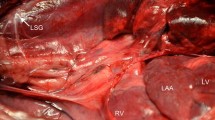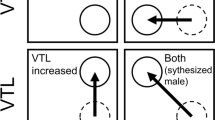Abstract
Eight inbred beagle dogs, litter mates of two generations, exhibited psychogenic vagotonia (long sinus pauses and transient atrioventricular block of the heart) during orienting to tones. This was intensified during tones following “one-trial conditioning” to a single painful leg-shock. It was potentiated during conditional stimuli (CS+) regularly reinforced by leg-shock; whereas unreinforced tones (CS−) elicited less vagotonia. Additional evidence of differentiation was observed in one dog when the differential magnitudes of the responses were reversed following reversal of the significance of the conditional stimuli. The possible mechanisms of these changes and correlations with clinical material are discussed. Results of this study illustrate the interplay between constitutional predisposition and psychological factors in prominent cardiovascular changes.
Similar content being viewed by others
References
Ayers, C. C., Boineau, J. P., and Spach, M. S.: Congenital complete heart block in children.Am. Heart J.,72:381–390, 1966.
Detweiler, D. K., Patterson, D. F., Hubben, K., and Botts, R. P.: The prevalence of spontaneously occurring cardiovascular disease in dogs.Am. J. Pub. Health,51:228–241, 1961.
Dykman, R. A., and Gantt, W. H.: Experimental psychogenic hypertension: Blood pressure changes conditioned to painful stimuli (schizokinesis).Bull. Johns Hopkins Hosp.,107:72–89, 1960.
Gale, E. N., and Stern, J. A.: Conditioning of the electrodermal orienting response.Psychophysiol.,3:291–301, 1967.
Gantt, W. H., and Hoffman, W. C.: Conditioned cardio-respiratory changes accompanying conditioned food reflexes.Am. J. Physiol.,129:360–361, 1940.
Gantt, W. H.:Experimental Basis for Neurotic Behavior. New York, Paul B Hoeber, 1944.
Gantt, W. H.: Cardiovascular components of the conditional reflex to pain, food and other stimuli.Physiol. Rev.,40:266–291, 1960.
Gazes, P. C., Culler, R. M., Taber, E., and Kelly, T. E.: Congenital familial cardiac conduction defects.Circulation,32:32–34, 1965.
Graham, F. K., and Clifton, R. K.: Heart-rate change as a component of the orienting reflex.Psychol. Bull.,65:305–319, 1966.
Hoffman, B. F.: Electrical activity of the atrioventricular node, inSymposium on the Specialized Tissues of the Heart, 1960. Amsterdam, Elsevier Pub. Co., 1961.
Linenthal, A. J.: Effects of carotid sinus reflex on cardiac impulse formation and conduction.Circulation,20:595–601, 1959.
Lynch, J. J.: The cardiac orienting response and its relationship to the cardiac conditional response in dogs.Conditional Reflex,2, 138–152, 1967.
Newton, J. E. O.: AV-block as a conditional response following faradic shock reinforcement.Physiologist,6:246, 1963.
Newton, J. E. O., and Perez-Cruet, J.: Cardiovascular responses to novel and conditional stimuli evaluated by successive beats.Physiologist,8:242, 1965.
Newton, J. E. O., and Gantt, W. H.: One-trial cardiac conditioning in dogs.Conditional Reflex,1:251–265, 1966.
Newton, J. E. O., and Perez-Cruet, J.: Successive-beat analysis of cardiovascular orienting and conditional responses.Conditional Reflex,2:37–55, 1967.
Newton, J. E. O.: Blood pressure and heart rate changes during conditioning in curarized dogs.Conditional Reflex,2:158–159, 1967.
Paes de Carvalho, A.: Cellular electrophysiology of the atrial specialized tissues, inSymposium on the Specialized Tissues of the Heart, 1960. Amsterdam, Elsevier Pub. Co., 1961.
Perez-Cruet, J., Newton, J. E. O., and Gantt, W. H.: Systolic blood pressure changes during two beat sinus arrhythmia.Physiologist,7:222, 1964.
Perez-Cruet, J., Newton, J. E. O., and Gantt, W. H.: Sinus arrhythmia during panting.Fed. Proc.,24:278, 1965.
Perez-Cruet, J., Plumlee, L. A., and Newton, J. E. O.: Chronic basal blood pressure in unanesthetized dogs using the ring-catheter technique.Proceedings of the Symposium on Biomedical Engineering,1:383–386, 1966.
Sokolov, E. N.:Perception and the Conditional Reflex. New York, Macmillan, 1963.
Teitelbaum, H. A., and Gantt, W. H.: The effect of nembutal anesthesia on the cardiac response to acetylcholine.Anesthesiology,16:261–269, 1955.
Teitelbaum, H. A., and Newton, J. E. O.: Cardiac inhibition in reaction to certain stimuli during pentobarbital anesthesia.Conditional Reflex,2: 169–170, 1967.
Vallbona, C., Cardus, D., Spencer, W. A., and Hoff, H. E.: Patterns of sinus arrhythmia in patients with lesions of the central nervous system.Am. J. Cardiol.,16:379–389, 1965.
Author information
Authors and Affiliations
Additional information
This research was supported in part by Grant HE-06945 from the National Heart Institute and in part by the Pavlovian Research Laboratory, VA Hospital, Perry Point, Maryland. Part of the work was done during the author's tenure as a USPHS Postdoctoral Fellow (NIMH).
Rights and permissions
About this article
Cite this article
Newton, J.E.O. Psychogenic vagotonia in a family of beagle dogs. Conditional Reflex 2, 302–322 (1967). https://doi.org/10.1007/BF03034129
Issue Date:
DOI: https://doi.org/10.1007/BF03034129




